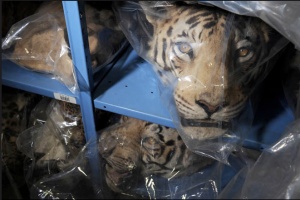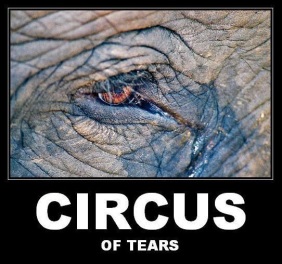ENDANGERED SPECIES ACT
Endangered Species Act (ESA), 16 U.S.C. § 1531, et seq.
Regulations Implementing the Endangered Species Act 50 CFR -Subchapter B
Many circus animals, such as elephants, tigers, and lions are legally protected by the Endangered Species Act (ESA).
Section 9 of the ESA – The “Take” Prohibition
Section 9 of the ESA generally prohibits the “Take” of a species identified under the ESA as endangered.
“Take” is broadly defined to mean “harass, harm, pursue, hunt, shoot, wound, kill, trap, capture, or collect, or attempt to engage in any such conduct.” 16 U.S.C. § 1532(19).
Take has also been interpreted to include not only harming or harassing the species directly but also by impairing habitat that may indirectly cause death or injury by disrupting feeding, breeding, or other essential behavior patterns. 50 C.F.R. § 17.3.
“Harm” in the definition of Take means an act which actually kills or injures wildlife. Such act may include significant habitat modification or degradation where it actually kills or injures wildlife by significantly impairing essential behavioral patterns, including breeding, feeding or sheltering. 50 C.F.R. § 17.3. There is no requirement that the harm to the species be intentional. Both direct and indirect harm can constitute unlawful “take” of a listed species. Babbitt v. Sweet Home Chapter of Cmtys. for a Greater Or., 515 U.S. 687, 704 (1995)
“Harass” in the definition of Take means: an intentional or negligent act or omission which creates the likelihood of injury to wildlife by annoying it to such an extent as to significantly disrupt normal behavioral patterns which include, but are not limited to, breeding, feeding, or sheltering. This definition, when applied to captive wildlife, does not include generally accepted:
(1) Animal husbandry practices that meet or exceed the minimum standards for facilities and care under the Animal Welfare Act,
(2) Breeding procedures, or
(3) Provisions of veterinary care for confining, tranquilizing, or anesthetizing, when such practices, procedures, or provisions are not likely to result in injury to the wildlife. 50 C.F.R. § 17.3.
Section 10 of the ESA – The Permit Process
Although Section 9 prohibits the “import of any endangered species into, or the export of any such species from the United States, there are several exceptions to this rule. First, there is an exemption for animals that were held in captivity prior to the enactment of the ESA or were captive at the time of the listing of the particular endangered species. 16 U.S.C. § 1538(b)(1).
Under Section 10, a “person” (including a corporation) seeking to engage in an activity that is otherwise prohibited by Section 9, must first obtain a permit from the Federal Wildlife Service (FWS), authorizing that activity. 16 U.S.C. § 1539. As part of the permit process, the FWS is required to publish notice of each permit application in the Federal Register, accept written comments from interested parties, and make public any information received as part of the application.
To apply for a permit, the applicant must provide (among other things) specific information on the “taking” that will occur and the reasons justifying such a “taking”. 50 C.F.R. §§ 17.22(a)(1); 16 U.S.C. § 1539(a)(1)(A). Under Section 10 (a)(A), the import or export of the animal(s) is permitted if it enhances the propagation or survival of the affected species. If the Applicant shows that the taking will “enhance the propagation or survival of the affected species”, the otherwise prohibited activity will be allowed. 50 C.F.R. § 17.22. This showing should be difficult to make, since harming, killing or otherwise “taking” an endangered species seems to thwart propagation and survival.
When a permit is granted pursuant to Section 10, there should be evidence that the exploitation of animals for entertainment and profit directly benefits the species. Animal circuses breed and hunt exotic animals for entertainment and business purposes only. They do not participate in rehabilitation and release programs. Permits are granted anyway.
The FWS has consistently interpreted the “enhancing the propagation or survival of the species” exception to showing that said use is of some “educational value”. Thus, circuses, roadside menageries and zoos, carnivals, etc. are routinely granted permits to import, export, take, and possess listed species under the guise that the display of these animals is educational. The FWS is aware that the real purpose of the animal circus show is not to educate or inspire, but to entertain. Animals are forced to perform unnatural behaviors in unnatural surroundings purely for pleasure and profit. What specific or general knowledge emerges from this sort of activity?

Section 11 of the ESA – The Citizen-Suit Provision
Section 11 of the ESA outline lays out the civil and criminal penalties for violations of any provision of the ESA.
There are different degrees of violation within the law. The most punishable offenses are trafficking, and any act of knowingly “taking” (which includes harming, wounding, harassing or killing) an endangered species. The criminal penalties for these violations can be a maximum fine of up to $50,000 and/or imprisonment for one year. Civil penalties are punishable by fines up to $25,000.
Section 11 also contains a citizen suit provision permitting , “any person” to commence a civil suit on his own behalf.” 16 U.S.C. § 1540(g)(1).
To establish standing, plaintiff must show:
(1) an injury in fact that is “concrete and particularized” and “actual or imminent”;
(2) that the injury is fairly traceable to the defendant’s challenged conduct; and
(3) that the injury is likely to be redressed by a favorable decision
Lujan v. Defenders of Wildlife, 504 U.S. 555, 560 (1992).
FEDERAL WILDLIFE SERVICE’S NEW UNWRITTEN RULE

Until 2011, the FWS issued permits to circuses under the broad exception that they enhanced the propagation or survival of the species through education. Since 2011, the FWS appears to have adopted an unwritten policy of considering the propagation or survival of the species condition met and issuing a permit if the circus applicant makes a contribution to a wildlife conservation group. In other words, the particular circus custom of chains, bullhooks, whips and starvation is irrelevant when deciding if the propagation condition has been met.
In 2017, Ringling Bros. circus, applied for an Endangered Species Act permit with the U.S. Fish and Wildlife Service to export 15 of its big cats to a circus in Munich, Germany, called Zirkus Krone. “What the service has done in the past,” explains Tony Eliseuson, senior staff attorney for the Animal Legal Defense Fund, “is that instead of having businesses prove that an import or export is going to benefit the species as a whole, they’ve allowed you to make a nominal donation to any kind of conservation group or purpose in exchange for rubber-stamping the permit.”Pay to Play
Despite its ongoing mistreatment of tigers, Hawthorn Corporation, has obtained various permits from the FWS, including permits to export tigers for commercial performance purposes. On or around May 9, 2013, Hawthorn received permits for the export and re-import of circus tigers after donating $50,000 to an Indian non-profit organization, Project Tiger. Hawthorn hired a lobbyist to secure the permits. Pay to play
In 2013, despite its notorious lack of care for elephants the Tarzan-Zerbini circus was granted a three-year permit to export and re-import two endangered Asian elephants to Canada, for commercial performance purposes. The permit was issued after Tarzan-Zerbini contributed $500 to a small non-profit called Asian Elephant Support.
The import or use of the endangered animal to perform in circus shows does not “enhance the survival” of that species, as intended by the ESA. The opposite is true. Allowing circuses to simply contribute money to conservation groups when they need a permit, in lieu of direct participation in species management, research, or legitimate educational programs contravenes the spirit of the Act.
 On February 23, 2011, Cole Brothers Circus and John Pugh, the president, pleaded guilty to violating the ESA by illegally selling two Asian elephants named Tina and Jewel to Mr. Davenport, a former employee, who planned to use them for private parties and elephant rides. Neither party possessed a permit that would have authorized such a sale. In accordance with the terms of the plea agreement, Pugh and Davenport were senten
On February 23, 2011, Cole Brothers Circus and John Pugh, the president, pleaded guilty to violating the ESA by illegally selling two Asian elephants named Tina and Jewel to Mr. Davenport, a former employee, who planned to use them for private parties and elephant rides. Neither party possessed a permit that would have authorized such a sale. In accordance with the terms of the plea agreement, Pugh and Davenport were senten ced to three years of probation, and 100 hours of community service for every year of their probationary term. Pugh was also sentenced to pay a $4,000 fine and make a $1,200 donation to an organization dedicated to the conservation of Asian elephants. Davenport was sentenced to pay a $5,200 fine. Cole Brothers Circus was sentenced to four years of probation and ordered to pay a $150,000 fine. Jewel and Tina were taken into federal custody and now live together at the Los Angeles Zoo. U.S. v. Cole Bros. All they have to do next time, is apply for a permit which they will likely obtain despite their bad record and lack of legal justification.
ced to three years of probation, and 100 hours of community service for every year of their probationary term. Pugh was also sentenced to pay a $4,000 fine and make a $1,200 donation to an organization dedicated to the conservation of Asian elephants. Davenport was sentenced to pay a $5,200 fine. Cole Brothers Circus was sentenced to four years of probation and ordered to pay a $150,000 fine. Jewel and Tina were taken into federal custody and now live together at the Los Angeles Zoo. U.S. v. Cole Bros. All they have to do next time, is apply for a permit which they will likely obtain despite their bad record and lack of legal justification.

